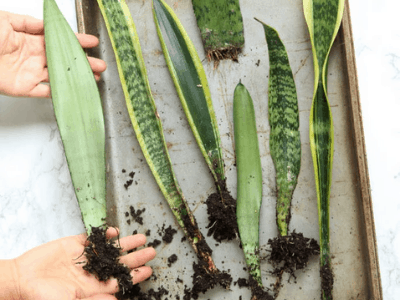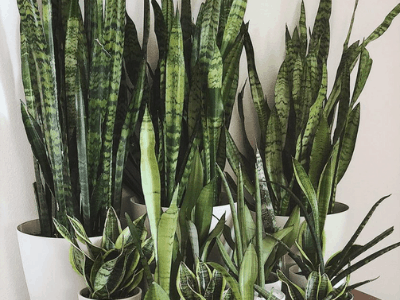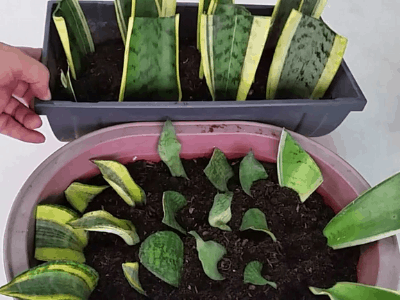
Propagating Snake Plant! Is It Needed?
Today I am going to talk about propagating snake plant. If you happen to have at least 2 snake plants…
…at home and you are considering the idea of attempting to do ths there are a few options…
…when it comes to propagating these easy-going plants. Through this post..
….I’ll share with you my sansevieria experiments I’ve carried out over the last few years…
…also known as ‘prop-experiments’. Propagation is a lot of fun for me because…
…it involves a lot of experimentation + it’s entertaining when you have success.
From the get-go, it’s important to know that this process is downright slow compared to popular trailing plants…
…like pothos, scindapsus, etc. It’s just something you have to practice patience with!
Also, although members of this family are often referred to as ‘low light’ varieties…
…this really refers to the plant’s ability to tolerate lower levels of light.
The plant will be happiest, and will have more opportunity to reproduce, in a position with fairly bright indirect light.
Take more time to adjust your plant to a brighter location gradually by doing this for around six weeks…
….if it has been kept in a darker place. In my old apartment, I grew my snake plants best near windows…
…and an exposed south western wall (I’m in the northern hemisphere).
They grew and flourished where I could watch them as well as enjoy them, and in more places than just a dreary spot in a corner!
The use of social media has led to a significant explosion in the popularity of snake plant propagation…
…but it’s clear from the messages I encounter in my inbox that there are still many new houseplant enthusiasts…
…lacking confidence about how to proceed. So let’s get started.
Before that lets take a look of Sue story about her experience having propagate snake plant
Let us hear Sue’s story
I’ve been trying to get my mom to buy some of these, but she thinks they’re a waste of money and space.
I can’t believe that’s what she really believes! She told me about how her dad would always try to grow plants…
…as a kid and they’d never last more than a few days before he moved on to the next thing.
So, finally I got home from school one day and saw this little pot with dirt in it sitting by the back door.
I was so excited because I thought Mom had bought them for herself after hearing all the hype…
….at work about how easy they are to propagate.
When I asked her where she got them, she said “I found them when we were gardening.”
This is something, this is a real sign that this snake plant is mean to part of my family.
After all of that, I search how to propagating snake plant on the internet.
In just 5 months now I have 5 of snake plant from the first snake plant that I had.

You can also root the plant from cuttings, but the fastest way to get a new snake plant is to divide it. The plant grows out from rhizomes which mass together and multiply as the plant gets older.
BONNIE L. GRANT, CERTIFIED URBAN AGRICULTURIST AND WRITER FROM GARDENINGKNOWHOW.COM
Here’s the main things
Propagate It With Water? Is It Possible?
Rooting and propagating snake plants, or Sansevieria, in water has got to be one of the most enjoyable propagation projects.
You can set it up very quickly and easily. What’s the hardest part? Waiting!
Let’s see how to water propagate snake plants! Also called mother in law’s tongue, this plant is found in temperate climates.
It depends on where you are from, but the common name can be different.
The accepted universal name for Sansevieria is the botanical genus Sansevieria.
You can root Sansevieria very simply in water. The process is as follows:
- Choose a healthy leaf, but not one that is too old.
- Cut the leaf off with a sharp pair of scissors.
- Allow the leaf cuttings to sit for a couple days to let the cut scab or callous over.
- Place in water and wait.

Choose a Healthy Leaf
Choose a fresh leaf, but not one that is too old. People and plants are very much alike.
As we get old, we no longer function like we used to, and are not quite as vigorous.
Make a few cuts if you can! This will make your chances of success much higher.

Here’s the main things
Cut Off The Leaf
Using scissors that are sharp and preferably sterilized, cut the leaf from the plant.
Cut a single leaf into sections, or even use multiple leaves.
Every section will grow baby plants! So from a single leaf, you can get multiple plants.
Try to find leaves segments that are between 2-3 inches long (5-7.5 cm). Or you can use the entire leaf.

Keep going
Allow It To Dry
This is not absolutely critical for Sansevieria, but I like to let the cuttings sit for a couple days..
…before placing them in water just in case. I have been successful both ways.
The goal of this is to prevent rotting on the leaf by drying, and callus over, any cuts on the leaf.
Place It In Water And Wait For It
That is the hard part. Sansevieria roots take a long time.
Sansevieria can also be rooted in water rather than in soil, however, it is actually quicker. Significantly faster!
If you choose to cut each leaf into multiple segments, you must remember one very important tip.
To grow the leaf segments correctly, keep them oriented the same way as they grew on the plant.
In the photo on the right, you can see that one leaf has been cut in half.
You cannot turn the leaf segments upside down or they won’t root.
Place the leaves or leaf segments in a glass or jar with a small amount of water.
In the case where you use a glass that is narrower at the bottom, it can hold the leaves in place so that the bottoms…
…of each leaf do not touch the bottom of the glass.
You can also use orchid clips or hair clips to hold the leaves in place so that they don’t rest at the bottom on the glass.
This will give the roots some room to grow. The roots will grow no matter what, but this is a little better.
Next Up
Secret Success To Propagate
Make sure to change the water frequently. I’d suggest starting with one to two times a week.
Change the water more frequently if you notice that it has become cloudy or dirty.
Even if you follow these guidelines, you will still run into issues, so here’s the real secret to growing Sansevieria…
…in water that no one is talking about!
It is crucial to get this right! You may notice that the leaf cuttings become slimy in the first part of the water propagation process.
That sounds gross right? Make sure you check your cuttings in water often! Don’t forget to check that.
Feel the parts of the leaves that were underwater while taking them out. If they are slimy…
…rinse them under warm or tepid water in the sink and gently rub them with your fingers to get rid of the slime.
Once all your cuttings are clean, you should also clean the container that you have your cuttings in with soapy water.
Add the fresh water and fresh slice cuttings into the mixture. Rinse well and add the cuttings back in.
Using this method will greatly reduce the chance of the cuttings rotting!
By a window, place the rooting cuttings. Having light that is indirect and bright, or even a small amount of sun…
…would be fine. Although I would advise against placing the cuttings in full sun, I would definitely avoid dark environments.
A final reminder: If you use a water softener system in your home, do not use this water for your plants!
Plants are harmed by these systems because sodium is added to the water.
Go On…
How Long It Will Take
Like I mentioned, you can actually propagate it using water much faster if you do!
Among all those I’ve communicated with on Telegram, the fastest I’ve heard is 15 days.
The results are unusual and unusually fast. This type of result is uncommon.
In general, it takes about 2 months before you see any roots emerge. Occasionally, it takes longer.
Root development can take as long as several months on sansevieria propagated by soil propagation…
…and pup development may take even longer.
If you start planting roots, you will have to wait a bit longer for pups to emerge.
Roots will come first, and then small pups will appear that are perfectly formed.
It is also important to remember that if you have a variegated plant, the pups you grow from leaf cuttings will not be variegated!
Take this beautiful variegated Sansevieria of mine:
Look at the beautiful yellow edges. Leaves taken from this snake plant will not be variegated if they are rooted.
If your goal is to have variegated offspring, you’ll have to divide the plant at the roots if your plant…
…has multiple crowns then divide the plant and pot up the various sections.
Here is one of my own water propagations and it took less than 6 weeks to root, which is pretty good!
A window on the Eastern wing was placed to allow for morning sun to reach the vessel.
If you want to hydroponically grow Sansevieria pups, and not plant them in soil…
….check out my blog on how to grow snake plants in water permanently.
I also show you how to separate the pups from the leaves in this post, and you can grow them permanently in water.
Here’s the main things
Pot Up Your Rooted Sansevieria Cuttings
Follow the procedure below if you would prefer to plant the pups in soil.
As soon as your leaves have already developed roots, you can pot up your plants in soil.
It is common for some people to wait until they can see the pups can grow before they pot them up.
Either way is fine in my opinion. Another rooted Sansevieria that I rooted in water ( Sansevieria cylindrica ).
This one took a few months and it still doesn’t have pups! That’s all folks!
How do you think Sansevieria propagation in water would go?
I encourage you to spread the word about houseplant care by sharing this post on social media!
______________________________________________________________________________________________________________________________
Sum Up
See having Snake plant is good choice for you to have! It’s cool, its famous, it’s easy to have and care!
What else do you need? In this pandemic time like this, is a good choice for you to have an new activity…
…and having snake plant is a good choice for you to have!
Conclusion
Last thing for sure. This plant need to be care carefully, remember plant need the “love” too.
Alright that’s all for today! Do you have any questions about all of this?
Or do you want to add some method for propagating and care snake plant so it can grow healthy?
Let me know your recommendation from the comment below.
There are still many recent and interesting articles about Snake Plants..
..as well as other unique information from All Things Gardener..
For further information and other inquiries you can contact us here
I hope you can now take care your snake carefully and grow it big!
Thanks for reading this article! Bye!

